We were planning a tour of the South Coast art galleries before covid struck. Now, sixteen months and a new camper van later, we have finally achieved it – or, at least, most of it.
After a slow and gruelling stagger along the M25, we arrived in Margate and made for the Turner Gallery, which is a simple building immediately next to the sea. It is an unassuming gallery, clearly able to put on fairly large-scale and interesting exhibitions.
I was very pleased to be introduced to the work of Ellen Harvey, a New York artist born in Britain. One room housed her large-scale work, ‘The disappointed tourist’ (oil on cradled Gessoboards). This comprised a huge wall of meticulous paintings of buildings, structures and sites that are ruined or no longer functional; and these were combined with a group of Turner paintings of ruined temples and towers. The effect was moving and thought-provoking, and seemed to make sense of the work of both artists.
Among Harvey’s other works on display was ‘The alien’s guide to the ruins of Washington’, which presented a similar theme,
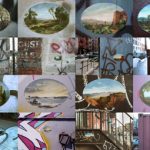 and a fascinating project entitled ‘New York Beautification Project’, in which she painted tiny, perfectly-executed graffiti cameos on items all around the streets of New York, intentionally confining herself to sites on which she did not have permission to paint her work. Here are some examples of the paintings with which she ‘beautified’ some items that are normally considered ugly.
and a fascinating project entitled ‘New York Beautification Project’, in which she painted tiny, perfectly-executed graffiti cameos on items all around the streets of New York, intentionally confining herself to sites on which she did not have permission to paint her work. Here are some examples of the paintings with which she ‘beautified’ some items that are normally considered ugly.
In the foyer of the gallery was a series of huge figures in charcoal and chalk, with accompanying audio, by the artist, Barbara Walker, entitled ‘Place, space and Who’. These magnificent figures represented different Caribbean characters.

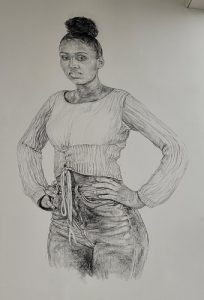
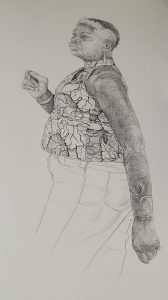
Outside, down on the beach, was an Anthony Gormley figure in the same series as his Crosby figures. As with those, I found this sculpture disconcerting as it was slowly drowned by the incoming tide
The next day we moved on to Hastings, where we had a ‘busy’ day, enjoying not only our visit to Hastings contemporary art gallery, but lunch with two (poetry) friends and tea at the home of another couple of (poetry) friends. It felt like the good old days of socialising.
In 2012 we went to the opening of what was, at that stage, the Jerwood Gallery, built partially to house the wonderful art collection of the Jerwood Trust. Unfortunately, it appears that some time in the last few years there has been an acrimonious falling-out of the gallery with the Jerwood Trust, which has consequently cut all ties with the gallery. This must have left the gallery pretty bereft of art works, but they have compensated for this by borrowing widely, with the result that the collection is well worth a visit.
One of the local celebrities in Hastings is Quentin Blake, who has maintained his connection with the gallery from the start. The large gallery downstairs (which used to be called the Foreshore Gallery) is given over to works by him. Being more used to Blake as the artist of whimsical, humorous sketches, I was quite taken aback by the power of the works on display in this room. A whole wall was taken up by a work entitled ‘The taxi driver’ (2020, acrylic on paper, but it looked more like charcoal), a work that, like other examples of his work displayed in the room, expressed his anxiety over the present state of the world.
Another wall displayed a series of stone heads, fallen in various positions and all slightly disturbing, There was, however, one series of drawings in what was more like Blake’s old whimsical style. This was called: ‘Hand in hand’ (2021, pen, ink & watercolour) and, with all the old punch of earlier drawings, they portrayed easily identifiable human emotions with just a few simple lines.
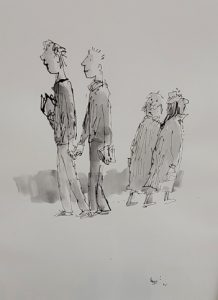
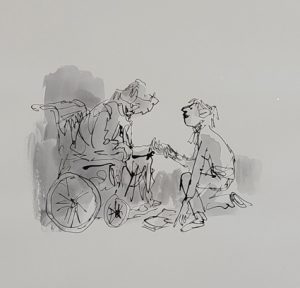
Unlike the Margate Turner and the Bexhill De la Warr Pavilion, there is an entrance fee for the Hastings Contemporary. But this great feast of art is worth every penny. There are, at present, works by so many wonderful artists, including David Jones, Eric Ravilious, Laura Knight, Paul Nash, L S Lowry, John Piper, Alfred Wallis, Ben Nicholson, Barbara Hepworth, Henry Moore and Bill Brandt.
Our next visit was to the De la Warr Pavilion in Bexhill, a gallery built in the Bauhaus style back in 1935-6. This has only a couple of rooms, and nothing very striking in the way of art. One room was taken up by an exhibition entitled ‘All in the same storm’ which comprised a number of mixed media sculptures, a couple of which were also situated outside on the terrace. Another room, upstairs, housed a collection of patchworks, writings and video on the theme of welcoming refugees.
I had never been to Bexhill before, and must admit it had something of the atmosphere of a time warp from the 1930s, so it felt appropriate to sit on the promenade eating ice creams before moving on to the campsite on Normans Bay for a delicious bathe in the sea.
All the art galleries were closed on Monday, so we knew in advance that the next day would not involve art. We had therefore planned to spend that day on the beach before moving on to Eastbourne on the Tuesday to visit the Towner Gallery. However, the weather had other ideas, and as the rain poured down and the temperature fell to 13 degrees, we decided to make for home, and visit the Towner on another occasion.